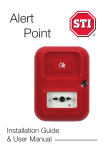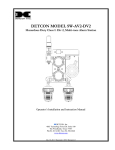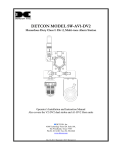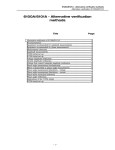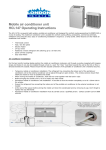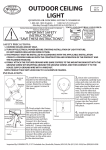Download Alert Point Install
Transcript
Alert Point Contents Page Installation Guide Introduction Box Contents & Key Components Specifications Alert Point Installation Removal of the Front Cover 2 3 3 4 6 User Manual Programmable Features Other Features Installing a 12-30V DC Power Supply Installing External Sounders Installing External Strobes / Beacons Installing External Detectors Networking the Alert Point Networking Features Troubleshooting PCB Terminal Diagram Using an Alert Point as a Manual Call Point (MCP) DIL switch settings - Programmable Features 8 9 10 11 12 13 14 16 17 18 18 19 Introduction The Alert Point is an aesthetically pleasing, robust and fully featured stand alone alarm system. Powered with a 9V DC alkaline battery, the Alert Point includes an integral sounder and resettable call point. Manufactured from tough polycarbonate, the Alert Point is designed for use in industrial as well as commercial or retail applications. Quick and easy to install and providing protection within minutes, the Alert Point is an ideal solution for establishments that have a requirement for a simple but effective alarm system. They may include: industrial/temporary buildings, warehouses, portacabins, churches, car parks, small offices and holiday parks etc. Where an EN54 fire system is decommissioned on a construction site, the Alert Point is ideal as a temporary system for raising an alarm in the event of an emergency. Installation Guide & User Manual Alertpoint Installation rev 1_2 Sep10 Available in a variety of colours, the Alert Point can be used for a wide range of applications such as fire, intruder, panic, evacuation, assist or general alarm. It also incorporates a tamper switch to prevent unauthorised removal or misuse. -2- Box Contents & Key Components Contents 1. 2. 3. 4. Step 1. Install the Reversible Mounting Plate 4. Installation Kit Reversible Mounting Plate (x1) Chassis (x1) Front Cover (x1) Installation Kit (x1) Reset Key Master Key Alert Point Installation The reversible mounting plate can be installed in any orientation; depending on the required conduit entry and exit points. Mark the 4 fixing points (as shown) and install using the screws and Rawlplugs provided. Pilot point x2 1” Screws (x4) 1. Reversible Mounting Plate Rawlplugs (x4) Fixing Points x4 2. Chassis Integral Sounder Pilot point x1 Master Key Switch Cylinder Step 2. Attaching the chassis Attach by pushing the chassis over the 4 fixing clips on the mounting plate (highlighted ). 9V DC Battery Fixing clip Tamper Switch Operating Element Step 3. Consult the User Manual for other programmable features (Programmable Features page 8 & DIL switch settings page 19) 3. Front Cover Step 4. Attach front cover Specifications Power source Standby current Alarm current Operating temperature Sounder output (at 1 metre) Sounder tones Tamper tone Network Line up each end using the channels located on the raised conduit sections (see detail). Push evenly until the cover locks into place via 4 raised mounting clips situated on each corner. 9V DC battery (supplied) or 12-30V DC 45µA 28mA low volume / 32mA high volume 0ºC to 49ºC 95dB – 102dB 7 1 >2 Alert Points spaced less than 50m apart -3- Detail -4- Alert Point Installation Removal of the front cover Step 5. Turn the unit `ON’ Using the 2 pips on the reset key provided, push firmly into each of the 4 corner clips individually, releasing them, whilst at the same time gently pulling the cover away from the remainder of the unit. Horizontal position - `0FF’. Vertical position - `ON’. Using the Master Key, turn the Key Switch Cylinder to the Vertical position. The LED will flash green when turned `ON’ – unit in `standby condition.’ Step 6. Test Depress the operating element. A warning indicator drops into view, the unit will alarm and the LED will turn red when the Alert point is activated. Step 7. Reset the unit Simply insert the reset key into the bottom of the Alert Point. A quick turn of the key and the Alert Point is reset, returning to `standby condition’ and is ready for use straight away. -5- -6- Programmable Features User Manual Settings 1. Integral Sounder Tones: DIL Switch No SW1 - SW3 The Alert Point has seven different selectable alarm tones ranging from 95dB to 102dB, along with a prefixed tamper tone. PCB Layout 2. External Power Provided (12-30V DC): DIL Switch No SW4 This setting allows the unit to be run from an external power source. DIL Switch 3. Relay Setting: DIL Switch No SW5 When part of a network, this setting allows the option of sending a triggering signal via the relay to an alarm panel, either: • Relay is only triggered on the activated unit • Relay sends triggering signal even when another unit is activated. 4. External Sounder/Strobe Trigger: DIL Switch No SW6 This setting allows the option of sending a triggering signal to externally fitted sounders, along with strobes/beacons. 5. Internal & External Sounder Timer Options: DIL Switch No SW7 & SW8 4 alarm durations are available and can be selected by changing the DIL switch settings. These are: continuous, 30 seconds, 3 minutes and 20 minutes. If any duration period other than `continuous’ is used, the alarm will silence after the selected time has elapsed. The LED will continue to flash red until the unit is reset using the reset key. 6. External Strobe Timer Options: DIL Switch No SW9 & SW10 4 strobe durations are available and can be selected by changing the DIL switch settings. These are: continuous, 30 seconds, 3 minutes and 20 minutes. If any duration period other than ‘continuous’ is used, the strobe will cease flashing. The Alert Point will still need to be reset, the LED will still flash red until this has been done. 7. Key Switch – Manual or Auto Reset: DIL Switch No SW11 This allows the user greater control if misuse becomes a major factor. Auto reset: The Alert Point will fully reset after activation when using the reset key. Manual: Even if the Alert Point is reset after activation using the reset key, all sounders and strobes will continue to run until the unit is reset using the master key switch. 8. Networking the Alert: DIL Switch No SW12 If this switch is `ON’ the Alert Point expects to be connected to another Alert Point otherwise a fault is indicated. If the switch is `OFF’ the Alert Point will not expect to be connected to another Alert Point. Note: DIL Switch settings are shown on page 19 -8- Installing External 12-30V DC Power Supply Other Features Integral sounder volume: The Alert Point has 2 volume settings – High and Low: this is determined by the position of the jumper connector configuration show below. Step 1. Ensure that the unit is switched `OFF’. Step 2. Insert the external power wires into the correct terminals. Step 3. Connect the 9V DC battery. The battery must be fitted as it will become a backup if there is a power failure. External Power + External Power - High: Jumper between centre pin and bottom pin (factory setting) Low: Jumper between centre pin and top pin PCB Layout To adjust the volume setting, lift off the jumper connector and then place over and push onto the selected pins Top Bottom Jumper connector Bottom Pin Step 4. DIL switch SW4 – should be `ON’ (external power required). Step 5. Turn the unit `ON’ using the master key switch. Step 6. The LED will illuminate to a constant green indicating that the unit is functioning correctly. Alarm Condition: If the unit is activated in the event of an emergency (depression of the operating element) it will immediately emit an alarm tone for the duration selected, an activation flag will drop into view and the LED will flash red every 8 seconds until the unit is reset. Resetting Unit: 1. DIL switch settings: changes will only take effect when the unit has been powered back up using the master key switch. 2. Silencing Alarm : If the operating element has been depressed the reset Key is to be used to reset the unit , returning it to Standby Mode. Note: Silencing the Alert Point is possible by not having the jumper fitted, but no sound will be produced by the integral sounder during alarm, fault or tamper conditions. Low battery check: Battery life: The Alert Point monitors the output power of the 9V DC battery in 16 minute cycles. If the battery falls below the recommended power level the unit will display a fault, emitting a periodic single beep. The working life of the 9V DC battery under normal `standby’ condition is a minimum of 15 months: it is recommended that this battery is replaced at least every 15 months. Battery back up: When the Alert Point is powered by a 12-30V DC power supply, the 9V DC battery will become a backup if the external power is lost. The unit will display a fault until the external power has been restored. External detector checking: The Alert Point is fitted with a 5V6 Zener end-of-line diode, enabling the unit to check for breaks in the external wiring loop of all the linked detectors. Even if external detectors are not fitted, the 5V6 Zener diode must remain connected to the Alert Point, otherwise a fault will be displayed. -9- Note: the master key switch can be used to silence the alarm but this will turn the unit ‘OFF’ and the alarm will continue to sound when the unit is turned back `ON’. Power Loss: In the event of any loss of power, the LED will turn red and emit a short beep every 90 seconds. The unit will still run safely using the 9V DC battery as a back up. As soon as power is restored the unit will automatically return to the `standby’ condition. Low or No Battery: If the unit is reset but the battery is at low power or not attached a fault will be indicated – the LED will turn red and the unit will emit a short single beep every 90 seconds. The unit automatically checks for low battery status every 16 minutes, during this period if the battery falls into low battery condition (or is disconnected in the presence of an external power source), the LED will turn red and emit a short beep every 90 seconds upon detection at the end of any 16 minute cycle. The battery will either need replacing or reconnecting and the unit reset before it will return to a standby condition. - 10 - Installing External Sounders Installing External Strobes / Beacons Step 1. Ensure that the unit is switched `OFF’. Step 2. Insert the external sounder wires into the correct terminals. Step 1. Ensure that the unit is switched `OFF’. Step 3. DIL switch SW6 – should be ‘OFF’ (external sounders/strobes to trigger during alarm Step 2. Insert the external strobe / beacon wires into the correct terminals. condition). Step 3. DIL switch SW6 – should be ‘OFF’ (external sounder(s)/strobes(s) to trigger during alarm Important: Please ensure all sounders have their own power source and are wired correctly in accordance with their own installation manuals. Warning: Incorrectly installed external devices may cause irreversible damage to the Alert Point. condition). Important: Please ensure all external strobe(s)/beacon(s) have their own power source and are wired correctly in accordance with their own installation manuals. Warning: Incorrectly installed external devices may cause irreversible damage to the Alert Point. Step4. Turn the unit `ON’ using the master key switch. Step 4. Turn the unit `ON’ using the master key switch. Step 5. The LED will now flash green every 8 seconds (or will remain constant if connected to an Step 5. The LED will flash green every 8 seconds (or will remain constant if connected to an external external power supply), indicating that the unit is functioning correctly. Step 6. Test: power supply), this indicates that the unit is functioning correctly. Step 6. Test: When the operating element is depressed, the unit will go into alarm condition: the externally When the operating element is depressed, the unit will go into alarm condition: the externally installed sounders should now sound. installed strobe(s)/beacon(s) should now flash. Step 7. Reset the Alert Point using the reset key, all sounders should now silence. Step 7. Reset the Alert Point using the reset key, all strobe(s)/beacon(s) should now cease flashing. Please note: If the `Auto Reset’ is disabled (DIL switch SW11 `OFF’) the sounders will continue Please note: If the `Auto Reset’ is disabled (DIL switch SW11 ‘OFF’) the strobe(s)/beacon(s) will to sound until the master Key switch is turned `OFF’. When turned back `ON’ the unit continue to flash until the master key switch is turned `Off’. When turned back `On’ the unit should be in `standby’ condition. should be in `standby’ condition. IMPORTANT: Enabling/Disabling external sounders will also enable/disable any strobes or beacons also wired to this unit. External Strobe / Beacon + External Strobe / Beacon - External Sounder + External Sounder - Note: All external sounders must be hard-wired using 2-core cable, and must have their own power supply. It is recommended that external wiring does not exceed 50 metres. Optional Internal Beacon An optional extra (not supplied as standard) for the Alert Point is the capacity to incorporate an internal beacon – this can provide for those who may be audibly impaired. Diagram of PCB terminal layout - 11 - - 12 - Installing External Detectors Networking the Alert Point Step 2. Disconnect the Zener diode. 5V6 Zener diode External detector + External Detector - Step 1. Ensure that both units are switched `OFF’. Step 2. DIL switch SW12 should be `ON‘ on both units (the Alert Point expects to be connected to a second unit). Network IN Networking only 2 units - (ensure the front cover is removed) Network OUT Step 1. Ensure that the unit is switched `OFF’. Network COM Any alarm condition to one of the Alert Points, will also trigger the linked units’ integral sounder and the LED (flash red) to indicate the fault. Any external output devices that are installed to any of the Alert points will also be activated if programmed to do so. Note: It is recommended that wire lengths between individual units do not exceed 50m (including ‘return loop’ wire between last & first units). With the front cover removed Step 3. Alert Point 1: Insert wires into the network terminals on the Alert Point (as shown opposite). Step 4. Alert Point 2: When connecting into the network terminals ensure the `Network In’ and the `Network Out’ wires are switched over (as shown below). Step 5. Turn the unit `ON’ using the master key switch. Step 6. The LED will now flash green every 8 seconds (or will remain constant if connected to an external power supply), indicating that the unit is functioning correctly. Step 7. To test the installation of the external detectors, firstly trigger one of the external detectors, this should send the Alert Point into `alarm ‘condition. Please note the Alert Point will only return to `standby’ condition, after the triggered detector has been reset. It is recommended that the maximum wiring length from the detector terminals on the Alert Point to the final detector in the loop, should not exceed more than 50 metres. - 13 - . . . Step 4. There is no DIL switch setting change to activate the external detectors, the Alert Point is constantly monitoring for a loop connection. The Zener diode creates the loop and must remain connected to the detector terminals at all times even if no detectors are being used. If the Zener diode is removed the Alert Point will trace a break in the loop and signal a fault. The Zener diode must be installed at the end of line when linking detectors off the detector terminals otherwise a fault will be signalled. Network IN Network COM Network OUT Step 3. Insert the external detector wires into the correct terminals, tighten down the corresponding terminal screws ensuring wires are securely trapped. . . . Warning: Incorrectly installed external devices may cause irreversible damage to the Alert Point. Network IN Network COM Network OUT Important: Please ensure all detectors have their own power source and are wired correctly in accordance with their own installation manuals. AP1 AP2 Step 5. Turn both units `ON’ using the master key switch. Step 6. Both LEDs will now flash green approximately every 8 seconds indicating that both units are functioning correctly. Step 7. TEST: Alert Point 1 Depress the operating element, this will send the Alert Point into `full’ alarm condition, with the activation flag dropping into view, the LED flashing red and integral alarm sounding. Alert Point 2: Will immediately trigger into alarm, the LED will flash red and the integral alarm will sound. Resetting the networked Alert Points, can only be done by manually resetting the original activated unit (e.g. Alert Point 1 from this test) using the reset key. This will return both units back into `standby ‘condition. Step 8. The above test should now be reversed. - 14 - Networking the Alert Point Networking Features AP1 AP2 . . . . . . . . . Network IN Network COM Network OUT Network IN Network COM Network OUT Network IN Network COM Network OUT In the example above the `Network In’ connection is lost on Alert Point 2. AP1 AP2 AP3 Resulting in 1. Alert Point 2 - The LED will flash red and a warning double beep will sound every 90 seconds. 2. Alert Point 1 - cannot trigger Alert Point 2 into alarm condition: the signal is lost to the `Network In’ connection on Alert Point 2. 3. Alert Point 2 can still trigger Alert Point 1 into `alarm’ condition as the connection remains intact between the `Network Out’ on Alert Point 2 and the `Network In’ on Alert Point 1. 4. Both units will still continue to work independently. 5. Alert Point 2 will instantly return to its `standby` condition when the connection is re-made, without* having to reset the unit. If both units lose their Network In or COMMON connections, they will both signal a fault. * Note: to check that the network is functioning correctly whilst avoiding having to wait 90 seconds for verification, turn the unit OFF then back ON using the master key switch (a fault will emit a double beep immediately on startup). Step 5. Important! On the final unit (e.g. Unit #3) ensure that the ‘Network Out’ terminal is linked back to the ‘Network In’ terminal on unit #1, creating a loop. (It is not necessary to do this step for the COM wire). Step 6. Turn all the units ‘ON’ using the master key switch. Step 7. TEST Alert Point 1, depress the operating element. This will send the unit into alarm condition, causing the activation flag to drop into view, the LED to flash red and the integral alarm to sound. Alert Points 2 & 3 will also immediately trigger into alarm, with LEDs flashing red and their integral alarms sounding. Step 8. Resetting the networked units can only be done by manually resetting the originally activated unit (showing the activation flag, in this case unit #1) using the reset key. This will return the other units back into ‘standby’ condition. - 15 - . . . Step 4. Insert a wire into the ‘Network Out’ terminal on unit #1, and link this to the ‘Network In’ terminal on unit #2. Now insert a wire into the ‘Network Out’ terminal on unit #2 and link this to the ‘Network In’ terminal on unit #3. Repeat this for each subsequent unit. Network IN Network COM Network OUT Step 3. Connect the ‘Network COM’ terminals by inserting a wire into unit #1, and linking this to the same terminal on unit #2. Now do the same by connecting an additional wire to the ‘Network COM’ terminal on unit #2, and linking this to the same terminal on unit #3. Repeat this for subsequent units until all units are linked. . . . Loss of connection between units: Any loss of connection between the networks will be indicated as a fault (double beep every 90 seconds) this will only be indicated on the unit expecting the input signal. Network IN Network COM Network OUT Step 2. DIL switch SW12 should be `ON‘ on all of the units (the Alert Point expects to be connected to another unit). Network OUT Network IN Step 1. Ensure that all of the units are switched `OFF’. Network COM Networking 3 or more units - (ensure the front cover is removed) Key Switch – Auto reset: DIL Switch No SW11 `ON’ – Auto reset. If an activated Alert Point is reset back to `standby condition’, a linked Alert Point will instantly return back to its own `standby’ condition. Key Switch – Manual reset: DIL Switch No SW11 `OFF’ – Manual reset. Only if an activated Alert Point is completely reset back to `standby condition’ using the master key switch, will a linked Alert Point reset back to its own ‘standby’ condition (using the master key switch on a linked Alert Point will have no effect on the network once it has been turned back ‘ON,’ until the initially activated unit has been attended to.) Please note: Tamper switch activation, low battery warning indication and no power source will only be signalled on the affected unit. - 16 - The Alert Point is constantly in `alarm' condition LED red & emitting a short double beep every 90 seconds Check installation Master key switch not turned `ON' Turn unit `ON' (vertical position) Front cover fitted incorrectly Check installation Reversible mounting plate incorrectly installed Check installation Operating element depressed Reset using reset key Networked - The linked Alert Point is in `alarm' condition Reset the `networked' Alert Point Tamper alarm activating Check installation Externally fitted detectors triggering Alert Point Check linked units are not alarming Networking DIL switch SW12 `ON' - but no network required DIL switch SW12 should be `OFF' Connection lost between the `networked' Alert Points Check all wiring connections (including COMMON) 5V6 zener diode not connected Check detector terminals Externally fitted detector connection broken Check all wiring connections LED red & emitting a short beep 9V DC battery output power insufficient every 90 seconds Low battery - change battery DIL switch no. SW4 'ON' - the unit is expecting external power, but not receiving any Check ext power lead connections / switch 'OFF' SW4 if no ext supply Reset key not resetting Alert Point when in `alarm' condition Auto reset option turned `OFF' DIL switch SW11 should be `ON' No sound in `alarm' condition Volume jumper connection loose or missing Ensure the jumper connection is fitted correctly External sounder DIL switch SW6 turned `ON' DIL switch SW6 should be `OFF' External sounder connection fault Check all wiring connections External strobe/beacon DIL switch SW6 turned `ON' DIL switch SW6 should be `OFF' External sounder connection fault Check all wiring connections External sounders not alarming on activation External strobe / beacons not flashing on activation External Sounder + External Sounder External Strobe/Beacon + External Strobe/Beacon External Detector + External Detector - 5V6 Zener diode DIL switch Terminal connections External power terminals Relay terminals External sounder terminals External strobes / beacons terminals Detector terminals General Maintenance: 9V DC batteries should be replaced every 15 months or sooner. Cleaning should be carried out using only mild, diluted detergents: concentrated solutions and those including (but not limited to) alkalis, strong acids, ethers, amines, aromatic hydrocarbons and alcohols can cause considerable harm to this product. NEED TECHNICAL SUPPORT? FREEPHONE 0800 085 1678 (UK) TELEPHONE: +44 (0) 1527 520 999 - 17 - Relay N.C. 12-30V DC power source installation fault Network OUT Connect correctly Network IN Possible Solution 9V DC battery clip not connected PCB Terminal Diagram Relay N.O. Relay COM Tamper alarm sounding Possible Cause Network COM No power External Power - Problem External Power + Troubleshooting Volume jumper connection ( 3 pins ) 12-30V DC Max 30V DC, 1A All external sounders need to be hard wired using 2 core cable and must have their own power supply. All external strobes & beacons need to be hard wired and must have their own power supply. All detectors need to be hard wired on a N.O. loop, have their own power supply and an end of line 5V6 Zener diode fitted (supplied with the unit). Using the Alert Point as a Manual Call Point Using the relay terminals, wire the positive loop connection into the N.O. terminal and the negative loop connection into the COM terminal. The unit will independently sound during `alarm condition’ as well as sending a trigger signal back the alarm panel. It is recommended that all external detector wiring does not exceed 50 metres. - 18 - DIL Switch Settings – Programmable Features Important: Changes made to any DIL switch settings will only take effect after the Alert Point has been reset using the master key switch. Features D I L S w itch S etting Integral Sounder Alarm Tone SW1 SW2 SW3 Tone OFF OFF OFF 1 800Hz - 970Hz (Sweep) ON OFF OFF 2 800Hz - 970Hz (Sweep) OFF ON OFF 3 988Hz / 250ms - 645Hz / 250ms (Alternating) ON ON OFF 4 670Hz / 250ms - 845Hz / 370ms (Alternating) OFF OFF ON 5 800Hz - 970Hz in 330ms (Sweep) ON OFF ON 6 2400Hz - 2850Hz in 110ms (Sweep) OFF ON ON 7 2400Hz - 2850Hz in 330ms (Sweep) ON ON ON 8 Not Implemented External Power Provided (12-30V DC) A ction Sound Pattern External power is to be supplied. NB: absence of power will indicate fault (LED flashing red ) No external power is to be supplied. NB: absence of power will not indicate a fault SW4 ON SW4 OFF SW5 ON Relay is only triggered on the activated unit in a network SW5 OFF Unit's Relay activates in a network even if this unit was not triggered SW6 ON External Sounders/Beacons are NOT triggered during `alarm' condition SW6 OFF External Sounders/Beacons are triggered during `alarm' condition Relay Mode Disable External Sounders & Strobes / Beacons Sounder Duration Timer Strobe / Beacon Duration Timer SW7 SW8 Sounder Duration OFF OFF Sounders run continuously (until manually reset) ON OFF Sounders switch off automatically after 30 seconds OFF ON Sounders switch off automatically after 3 minutes ON ON Sounders switch off automatically after 20 minutes SW9 SW10 Strobe / Beacon Duration OFF OFF Strobes / Beacons run continuously (until manually reset) ON OFF Strobes / Beacons switch off automatically after 30 seconds OFF ON Strobes / Beacons switch off automatically after 3 minutes ON ON Strobes / Beacons switch off automatically after 20 minutes SW11 ON Auto Reset SW11 OFF SW12 ON Networking the Alert Point SW12 OFF Alert Point returns to `standby' condition after resetting with the reset key Alert Point latches in 'alarm' condition until it is manually reset using the master key switch The Alert Point expects to be connected to another Alert Point, otherwise a fault is indicated (LED flashing / constant red) No fault will be indicated if an Alert Point is not connected to another Alert Point, it is not looking for a connection Factory settings - 19 - Safety Technology International (Europe) Ltd. Safety Technology International, Inc. Unit 49G • Pipers Road • Park Farm Industrial Estate Redditch • Worcestershire • B98 0HU • England Tel: +44 (0) 1527 520 999 Fax +44 (0) 1527 501 999 Email: [email protected] Web: www.sti-europe.com 2306 Airport Road • Waterford • Michigan • 48327 Tel: 248 673 9898 Fax: 248 673 1246 Email: [email protected] Web: www.sti-usa.com Alertpoint Installation rev 1_2 Sep10_webversion.










